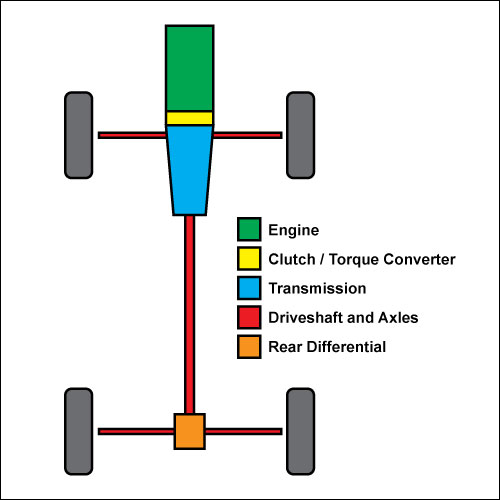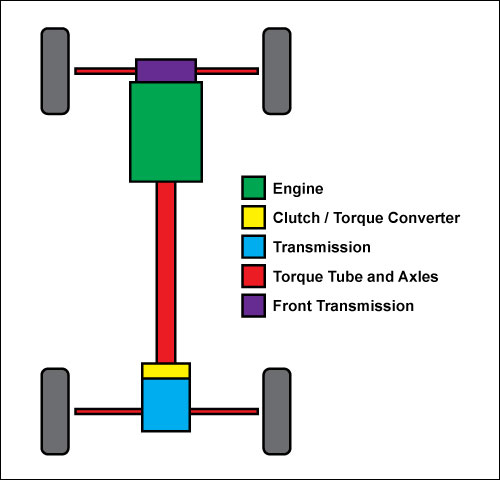Technical Curiosities:
An Automotive AWD System Primer

Prompted by a recent online forum discussion wherein I explained the difference between BMW’s and Audi’s AWD powertrain layouts, I thought I’d put together a short rundown of front-engined AWD solutions.
I’m sure I’ve overlooked a configuration or two. If you think of one I haven’t covered, post a comment and I’ll add it to this primer!

Standard layout – The illustration above depicts what I’ll call the standard layout—basically a RWD setup with a transfer case attached to the rear of the transmission, sending power to the front wheels via a secondary driveshaft, front differential and axles. All four wheels must be able to turn at different speeds for dry pavement use, so the standard layout incorporates a center differential within the transfer case.
Advantages of this layout include the ability to position the engine further rearward for better weight distribution within the chassis, and the fact that it’s a relatively simple affair to convert a RWD car to AWD using a few extra parts. Among the downsides are additional complexity compared to the other methods described below, as well as a higher center of gravity since the front differential and axles must fit under the engine, and the transfer case and secondary driveshaft run beneath the car as well.
Automakers that use this layout: BMW, Mercedes, Nissan, Infiniti, Cadillac, etc.

Standard transverse layout – Similar to the first configuration, the standard transverse layout is a conversion of a “regular” 2WD (in this case FWD) powertrain setup to AWD. A transfer case, including a center diff, is attached to the rear of the transmission and sends power to the rear wheels through a (long) driveshaft and conventional rear diff and axles.
It’s a relatively compact setup, and commonly added to FWD cars. That said, the engine placement is still limited and the fact that so many components are concentrated near the front of the car means weight distribution is very often less than ideal. Also, the front-rear torque split is almost invariably biased toward the front wheels, only sending power to the rears when the front start to slip, making the car for all intents and purposes FWD, except in certain select circumstances.
Automakers that use this layout: Volkswagen, Mitsubishi, Mazda, etc.

All-in-trans layout – Subaru and Audi pioneered this layout in the ’70s and ’80s, respectively. Everything, including the front diff, is contained inside the transmission casing, and the front axles simply sprout from the sides of the bellhousing.
Both the upsides and disadvantages of the all-in-trans layout are significant. Its configuration is simpler and more compact than any other, and comparatively very robust. Also, having all the mechanicals “on the same plane” allows the car’s CG to be relatively low. All that said, a quick glance at the schematic above reveals the layout’s major downside: The engine must sit fully in front of the transmission and front axle line, utterly destroying any hope of reasonable weight distribution. To Audi’s credit, in the past 5 years or so, they’ve managed to rearrange components inside the transmission such that the front axle line can now move in front of the clutch, improving weight distribution slightly. Better—but they’re still a long way from a 50-50 front-rear balance.
Automakers that use this layout: Audi, Subaru, some Volkswagens (those built on platforms shared with higher-end Audis).

Both-ends layout – This one’s rather creative. It represents Ferrari’s solution to the “AWD problem” and was first introduced with their 2011 FF top-of-the-line shooting brake. Instead of siphoning power from the back of the engine to send forward, the FF’s V12 has a second transmission mounted to the front of the engine, without a differential, sending power to the front wheels via a pair of clutches. For its part, the actual transmission is mounted at the rear of the car in a classic performance car transaxle layout.
The boon to weight distribution from the both-ends layout is clear: The entire engine can, and indeed must, be pushed behind the front axle line. It’s relatively simple, mechanically. But the car’s wheelbase and styling proportions have to follow the layout, and can look rather stretched, as any consideration of the FF’s profile will attest to. Also, the lack of a front differential limits the power sent forward to only 20% of the engine’s output, not a great help in many situations.
Automakers that use this layout: Ferrari.
Editor’s note: This post is part of an ongoing series spotlighting obscure automotive engineering solutions. Read the other installments here:

You forgot the GTR’s front engine/rear transaxle solution. Yes, like the laborghini’s it’s an adpatation of the first layout, but with diferente weight distribution…
Good point. I’ll add a note about the GT-R’s configuration to the “standard layout” section.
I was going to add another layout but when I checked out Gus’s post, I see that ‘my’ one is essentially the same as the GT-R but much earlier (and not strictly a road car):
the ‘Austin Champ’ was an offroad Jeep/Landrover type vehicle for the military that must have been designed with little regard to cost. It too had the (Rolls Royce)engine at the front, the transmission at the back and a second propeller shaft to relay the drive back to the front differential from the rear, and all independent suspension.
(I don’t think this or the GT-r can be called ‘standard layout’!)
AWD Porsche 911’s are of the “all-in-trans”-type, just front-to-back compared to front-engined users of the system, for obvious reasons. :)
How interesting that you mention that everything is contained inside the transmission casing. My husband and I want to get a four wheel drive this summer. We will also find a good four wheel drive accessory company in our area.